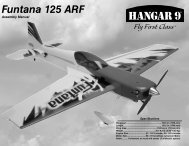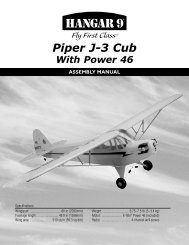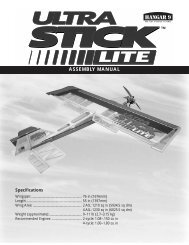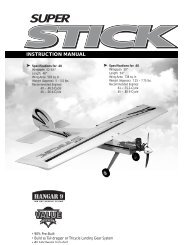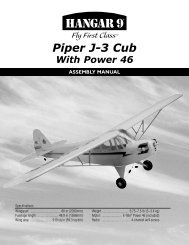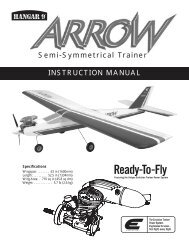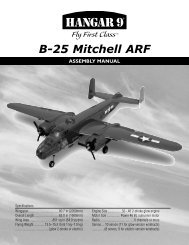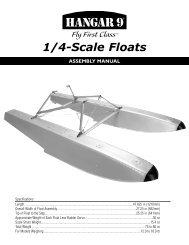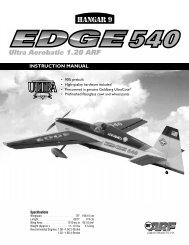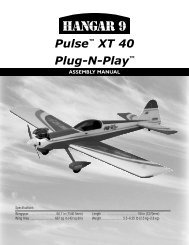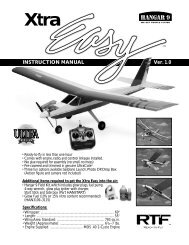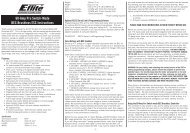Hangar 9 Pizazz Manual
Hangar 9 Pizazz Manual
Hangar 9 Pizazz Manual
You also want an ePaper? Increase the reach of your titles
YUMPU automatically turns print PDFs into web optimized ePapers that Google loves.
TMWE GET PEOPLE FLYINGTMINSTRUCTION MANUAL• 90% prebuilt• Hardware included• Precovered with <strong>Hangar</strong> 9 UltraCote ®• Incredible 3-D/fun-fly performerSpecifications:• Wingspan: ............................................................................................................ 48 in (1219 mm)• Overall Length: ................................................................................................... 48 in (1219 mm)• Wing Area:................................................................................................ 725 sq in (46.8 dm sq)• Weight (Approx.): ................................................................................. 4.5-5.5 lbs (2.0-2.5 kg)Recommended Engines: 2-Cycle: .40-.584-Cycle: .50-.72
Table of ContentsIntroduction . . . . . . . . . . . . . . . . . . . . . . . . . . . . . . . . . . . . . 3Warning . . . . . . . . . . . . . . . . . . . . . . . . . . . . . . . . . . . . . . . . 3Additional Required Equipment . . . . . . . . . . . . . . . . . . . . . . . 3Kit Contents . . . . . . . . . . . . . . . . . . . . . . . . . . . . . . . . . . . . 5Section 1: Installing the Wing . . . . . . . . . . . . . . . . . . . . . . . . 6Section 2: Hinging the Ailerons . . . . . . . . . . . . . . . . . . . . . . . 8Section 3: Installing the Aileron Servos . . . . . . . . . . . . . . . . 10Section 4: Installing the Aileron Linkages . . . . . . . . . . . . . . 12Section 5: Installing the Horizontal Stabilizer . . . . . . . . . . . . 14Section 6: Installing the Vertical Stabilizer (Fin) . . . . . . . . . 16Section 7: Installing the Rudder and Tail Wheel Assembly . . 18Section 8: Hinging the Elevator . . . . . . . . . . . . . . . . . . . . . . 20Section 9: Installing the Rudder and Elevator Control Horns 21Section 10: Assembling the Fuel Tank . . . . . . . . . . . . . . . 23Section 11: Installing the Engine . . . . . . . . . . . . . . . . . . . . 25Section 12: Installing the Radio System . . . . . . . . . . . . . . . 27Section 13: Installing the Rudder, Elevator,and Throttle Pushrods . . . . . . . . . . . . . . . . . . . . 29Section 14: Installing the Main Landing Gear . . . . . . . . . . . . 33Section 15. Installing the Canopy . . . . . . . . . . . . . . . . . . . . 34Section 16: Control Throw Recommendations . . . . . . . . . . . .35Section 17: Balancing the <strong>Pizazz</strong> . . . . . . . . . . . . . . . . . . . . .35Preflight at the Field . . . . . . . . . . . . . . . . . . . . . . . . . . . . . . .36AMA Safety Code . . . . . . . . . . . . . . . . . . . . . . . . . . . . . . . . .37IntroductionThank you for purchasing one of the finest Sport 3-D fun-flymodels available. The <strong>Pizazz</strong> is an outstanding model for clubfun-fly events and also is a great 3-D sport aircraft. The <strong>Pizazz</strong>uses a conventional two-aileron setup, with separate servosfor each aileron, allowing the you to program each aileronseperately. This is especially useful for “flapperon” configurationof the control surfaces.This configuration offers excellent slow speed and stallcharacteristics that allow even inexperienced pilots to feel athome. Plus, it offers aerobatic capabilities that will have yourflying buddies drooling.To get the most out of your <strong>Pizazz</strong>, we strongly suggest usinga computer radio system. This allows you to explore the variousmixes available with computer radio systems.With a little practice, you could be doing 3-D tricks you neverthought possible. Plus, you’ll have fun learning about yourcomputer radio and its capabilities.If you encounter difficulty in any construction sequence, pleasecontact one of our technicians—we stand ready to provide anyassistance we can concerning the construction of your <strong>Pizazz</strong>.You can contact us at:Horizon Hobby, Inc.4105 Fieldstone RoadChampaign, IL 61822(217) 355-9511www.horizonhobby.comWARNINGAn R/C aircraft is not a toy! If misused, it can cause seriousbodily harm and damage to property. Fly only in open areas,preferably AMA (Academy of Model Aeronautics) approvedflying sites, following all instructions included with your radioand engine.Don’t miss out on the fun.Additional Equipment RequiredRadio Equipment• 4 channels (minimum)• 5 servos (JR 537 or equivalent)• Standard 600–1100mAh receiverbattery packRecommended JR ® Systems• JR Quattro• JR XP652• PCM10X• PCM10SX• JR F421EX• JR XP631• JR XP8103• PCM10SXIIJR XP81033
Engine Requirements• .40-.58 2-cycle engines• .50-.72 4-cycle enginesRecommended 2-Cycle Engines• MDS .48FS Pro/MDS .58FS ProRecommended 4-Cycle Engine• Saito .56/ Saito.72MDSE058SAIE072Parts Needed (not included in kit)• Aileron Extension - 3" (2) (JRPA093)• Propeller (refer to propeller recommendations for theoperating instructions of your engine)• Foam for cushioning tank and radio• Fuel tubing - 12"• Spinner or prop nut (DuBro red aluminum spinner nut used on prototype)Tools and Supplies Needed (not included in kit)Adhesives• Thin CA (cyanoacrylate) glue• Medium CA (cyanoacrylate) glue• Thick CA (cyanoacrylate) glue• CA remover/debonder• Masking tape• 6-minute epoxy• 30-minute epoxy• 242 threadlock/blue threadlockTools• Drill• Drill Bit: 1/16”, 3/32", 1/8"• Medium Phillips screwdriver• Z-bend pliers• Needle-nose pliers• Hobby knife with #11 blade• Mixing sticks• Epoxy brush• 90-degree triangle• Medium sandpaper• Straight edge• Measuring device (e.g., ruler, tape measure)• Scissors• Paper towels• Wax paper• Rubbing alcohol• Felt-tipped pen/pencil• T-pins• Toothpicks (optional)• Moto-tool with cut-off wheel4
Section 1: Installing the Wing onto theFuselageParts Needed• Wing (without ailerons)• FuselageTools and Adhesives Needed• 30-Minute epoxy• Rubbing alcohol• Paper towels• Hobby knife w/#11 blade• Epoxy brush• Mixing stick• Felt-tipped pen or pencilsnug fit but not at the expense of crushing the wing structure.Step 3. Measure the distance the wing projects on either sideof the fuselage, to make sure it is centered in the fuselage.Thenmeasure from each wing tip to the center of the fuselage at therear to be sure it is square with the fuselage. Mark the wing andfuselage junction with a pencil on both sides of the fuselage onConstruction of wing attachment to the fuselage begins with anexamination of the wing and fuselage. Note that each aileron willbe controlled by its own servo. You will need two servos whenyou begin Section 2. We recommend a servo that has 40 oz/inof torque or greater, such as the JR 537 servo that comes standardwith JR radio systems. The JRP368 Micro Digital Servo isalso excellent choice to use in the <strong>Pizazz</strong> to save weight, butrequires a little modification for the servo rails.Step 1. Measure the wing length to establish the center line ofthe wing and mark with a pen or pencil.the wing. This will establish the reference points of a centeredStep 2. Carefully slide the wing into the fuselage opening(the servo openings in the wing should face the bottom of thefuselage as shown. Do not force the wing as you may crushthe structure. Some trimming may be required. You want a fairlywing for the next phase, epoxing the wing to the fuselageStep 4. Remove the wing. Use a sharp hobby knife to remove6
the covering 1/8" inside the line you marked on the wing (topand bottom). Use care not to cut the balsawood, as this willweaken the structure. You want a wood to wood joint so theStep 6. Wipe away excess epoxy with rubbing alcohol and apaper towelepoxy will adhere to the fuselage/wing joint securely.Reinstall the wing into the fuselage. Once you are satisfied withthe fit of the wing to the fuselage, and are sure it is centered, mixup approximately 1 ounce of 30-minute epoxy.Step 7. Realign the wing as done in Step 3. Allow the epoxy tocure completely before proceeding to the next step.Step 5. Apply the epoxy to both sides of the wing center, topand bottom. To apply epoxy to top, slide wing off center andapply epoxy from outside of fuselage on both sides. Slide thewing back and forth to work epoxy into the joint of thewing/fuselage.7
Section 2: Hinging the AileronsParts Needed• Ailerons with hinges• Wing/fuselageTools and Adhesives Needed• Instant thin CA glue• CA remover/debonder• Paper towels• T-pins (one for each hinge)aileron until the T-pin is snug against the wing.Step 4. Slide the left aileron onto the wing until there is onlya slight gap. The hinge is now centered on the wing panel andaileron. Remove the T-pin and snug the aileron against the wingStep 1. Locate the aileron pieces and hinges for the wing.panel. This will ensure that the hinges are centered.Step 2. The <strong>Pizazz</strong> comes with high-quality CA type hinges.Locate the CA hinges included and place a T-pin into the outsideedge of each hinge. Be sure the hinge remains centered whileStep 5. Deflect the aileron and completely saturate the hingewith thin CA glue. The aileron’s front surface should lightlycontact the wing during this procedure. Ideally, when the hingeis glued in place, a 1/ 32" gap or less will be maintainedthroughout the length of the aileron. The hinge is constructedof a special material that allows the CA to wick or penetrateinstalled into the control surface.Step 3. Slide a hinge into the hinge slot of the wing for eachand distribute throughout the hinge, securely bonding it tothe wood structure.Step 6. Turn the wing panel over and deflect the aileron in the8
opposite direction from the opposite side. Apply thin CA glue toeach aileron hinge, making sure the CA penetrates into both theaileron and the wing.Step 9. After both ailerons are securely hinged, firmly graspthe wing and each aileron to check that the hinges are securelyglued and cannot be pulled apart. To do this, apply mediumpressure while trying separating the aileron from the wing, usingcaution to be certain you don’t crush the wing structure. Movethe ailerons up and down several times to “work in” the hingesand check for proper movement.Step 7. Using CA remover/debonder and a paper towel, removeany excess CA glue that may have accumulated on the wing or inthe aileron hinge area.Step 8. Repeat this process with the right aileron, securelyhinging the aileron in place.9
Section 3: Installing the Aileron ServosParts Needed• Wing/fuselage• Standard size servos with mounting hardware (2)• Servo extension -3" (2) (JRPA092 -3" Gold)Tools and Adhesives Needed• Hobby knife• Medium Phillips screwdriver• Drill• Drill Bit: 1/16"• Masking tape• Pencil• String with weight on end• Needle-nose pliersStep 3. With the servo in place, mark the location of the servoscrews and then remove the servo.Step 1. Install the recommended servo hardware suppliedwith your radio system onto your servos (grommets and eyelets).Install a servo extension lead to the servo as well. Tie theconnectors into a knot and secure the connectors withelectrical tape to prevent the servo lead connections frombecoming disconnected.Hint: It’s always a good idea to tape or secure the servoconnectors and servo extension together to prevent thewires from becoming unplugged inside the wing.Step 2. Trial fit the servo into the servo opening. Dependingupon the type of servo installed, some trimming may berequired. Note that the servo is orientated so the servo arm iscloser to the trailing edge of the wing.Step 4. Using a 1/16" drill bit, drill the servo screw locationsmarked in Step 3.Step 5. Repeat the procedure for the other servo.Step 6. Before mounting the servos in the wing, it’s suggestedthe servo lead and extension be run through the wing and outthe opening in the wing center bottom.Note: The opening in the wing bottom will also serve as theplace where the radio and servos are mounted in thefuselage/wing assembly.Step 7. Tape the lead to the wing to keep it from falling backinto the opening. It may be easier if you thread one servo lead ata time.10
Step 8. Securely fasten the left servo in the appropriateopening with four of the servo mounting screws supplied withyour radio system.Step 9. Repeat the procedure for the other aileron servo.Note: It is recommended to have each servo connected to aseparate channel in the receiver if your radio systemhas flap compatibility. This will allow for flaperonfunction. Please refer to your radio system operatinginstructions for selection of the flaperon wing programso you can set up the <strong>Pizazz</strong> control surfacesfor this feature.11
Section 4: Installing the Aileron LinkagesParts Needed• Wing/fuselage assembly• Short rods, threaded on one end (2)• Clevis (2)• Control horn (2)• Control horn mounting screws• Clevis keepers (2 pcs of fuel tubing 7mm long)(not provided)Tools and Adhesives Needed• Medium Phillips screwdriver• Drill• Drill Bit: 1/16"• Felt-tipped pen• Z-bend pliersStep 3. The control horn should be positioned so the holesthat the clevis connects onto are over the centerline of the hingeline of the control surface. Once satisfied with the horn location(it should be a straight line from the servo arm to the horn),mark the location with a felt-tipped pen.Step 1. Locate the short rods threaded on one end, clevis, andkeepers. You will also need a control horn, control horn backplate,and mounting screws to mount the control horn to thecontrol surface. The instructions will refer to construction of justone linkage and control horn. Assembly and installation for theother aileron will follow this same sequence.Step 4. Using a 1/16" drill bit, drill the screw holes formounting the control horn.Clevis Keeper,7mm piece ofsilicon fuel tubingShort Rod, threaded on one endClevisControl HornControl HornBackplateControl HornMounting ScrewsStep 2. Before assembly and mounting the linkages/controlhorns, it’s a good idea to center the aileron servos. Connectthem to the receiver, turn on your transmitter, then the receiver.Once the servos have moved to their electrical center, you canposition the servo control arm so that it will be approximately90 degrees to the linkage when it’s attached. It’s important thatthe mechanical adjustments are made as closely as possiblebefore attempting to make any electrical adjustments throughthe transmitter programs.Step 5. Attach the control horn to the aileron using the screwsand the control horn backplate. Be careful not to accidentallypuncture the covering with the screwdriver.12
Step 6. Thread a 2-56 clevis on the end of one of the threadedrods. Screw the clevis on 7-10 turns. Install the clevis with wireon the control horn into the third hole from the mounting base.Step 8. Make a “Z” bend in the rod at the location you justmarked.Be sure to install the clevis keeper (piece of fuel tubing) overthe clevis.Step 9. Insert the “Z” bend through the second hole from theend of the servo arm. Install the clevis back onto the controlhorn. Be sure to slide on the silicon clevis keeper onto the endof the clevis.Step 7. With the linkage attached to the control horn, center thecontrol surface and hold the linkage wire directly over the electronicallycentered servo arm. Place a mark on the rod directlyStep 10. Repeat the process for the other aileron linkage.over the hole (second hole from the end of arm) in servo controlarm that it will connect too.13
Section 5: Installing the Horizontal StabilizerParts Needed• Horizontal stabilizer• Fuselage/wing assemblyTools and Adhesives Needed• Hobby knife• Ruler• Felt-tipped pen• Pencil• 30-minute epoxy• Paper towels• Rubbing alcohol• Mixing stick• Epoxy brush• Masking tapeNote: Before assembling the tail, be sure the elevator and theCA hinges are removed from the horizontal stabilizer.The hinges and elevator will be installed later.Step 1. Measure and mark the center of the horizontal stabilizeron its leading and trailing edge.Step 2. (Continued)Step 3. Align the horizontal stabilizer by measuring from fixedpoints on the wing to the outside of the trailing edge tip of thehorizontal stabilizer. Be sure that the trailing edge of theStep 2. On the top of the aft end of the fuselage is a saddle cutoutfor the horizontal stabilizer and vertical fin to be mounted.Use a sharp hobby knife to remove the trim from the slots in thefuselage. Make a center mark on the front of the saddle on thefuselage and place the horizontal stabilizer into the horizontalstabilizer saddle. Align the two marks you just made. Tape theleading edge and trailing edge of the horizontal stabilizer to thefuselage to secure it for now.horizontal stabilizer stays on its center mark.14
Step 4. Adjust the stabilizer until you have an equal distance onboth the right and left sides of the stabilizer to the wing.Step 5. When you’re satisfied with the alignment of theStep 8. Mix approximately 1/2 ounce (minimum) of 30-minuteepoxy to install the horizontal stabilizer to the fuselage. Using anepoxy brush or mixing stick, spread the epoxy onto the bottomof the horizontal stabilizer where it comes into contact with thefuselage. Also, coat the stabilizer saddle area that will come incontact with the horizontal stabilizer.Step 9. Lay the fuselage onto a flat surface and position thehorizontal stabilizer onto it, making sure it’s centered and alignedas in Steps 3 and 4.Hint: Reference the bare wood you just exposed to re-alignthe stabilizer. Use masking tape to hold the horizontalhorizontal stabilizer with the wing, carefully mark the positionwith a pencil at the junction where the horizontal stabilizermeets the fuselage, both top and bottom. The pencil shouldleave a slight indentation in the covering.Step 6. Remove the horizontal stabilizer from the fuselage.Using a hobby knife and a straight edge, carefully cut thecovering approximately 1/16" inside the lines you drew.Caution: It’s very important that you do not press hardenough to cut into the wood structure, as doingso will weaken the horizontal stabilizer.Step 7. With the fuselage and horizontal stabilizer together onstabilizer in place while the epoxy cures.Note: Be sure that the horizontal stabilizer and fuselage areassembled on a firm, flat surface and that they arelevel with each other. Now re-check the alignment asin Steps 3 and 7 and from the front to be sure the stabilizeris parallel to the wing and adjust if necessary.a flat surface, check to be sure the wing and horizontal stabilizerare parallel with each other. If adjustment to the horizontalstabilizer saddle is necessary because the wing and stabilizerare not parallel, carefully trim the horizontal stabilizer saddleto adjust as necessary.Step 10. Wipe off any excess epoxy using a paper towel andrubbing alcohol. Allow the epoxy to cure fully before proceedingto the next step.15
Section 6: Installing the Vertical Stabilizer (Fin)stabilizer. Make sure the rear of the vertical stabilizer (where thehinge slots are located) is aligned with the rear of the fuselage.Note: The elevator should not be hinged to the horizontalstabilizer at this time. It will be attached later.Step 3. Mark the vertical stabilizer on both sides where it exitsParts Needed• Vertical stabilizer with rudder• Fuselage/wing assemblyTools and Adhesives Needed• 30-minute epoxy• Hobby knife• Pencil• Masking tape• Rubbing alcohol• Paper towels• 90-degree triangle• Epoxy brush• Mixing stickthe fin blocks.Step 4. Remove the vertical stabilizer and carefully cut away thecovering with a sharp hobby knife just inside the lines youmarked in Step 3.Step 1. Remove the rudder and hinges from the verticalstabilizer if you have not already done so. The rudder will beattached (hinged) to the vertical stabilizer later.Step 2. Trial fit the vertical stabilizer onto the fuselage andCaution: Do not cut into the wood of the vertical stabilizerwhen cutting the covering, as doing so willweaken the structure.Step 5. Mix approximately 1/4 ounce (minimum) of 30-minuteepoxy and apply it to the vertical stabilizer where it comesinto contact with the fin block. Also apply epoxy to the baseof the vertical stabilizer where it comes in contact with thehorizontal stabilizer.Step 6. Insert the fin onto the fuselage. Wipe away any excessepoxy using a paper towel and rubbing alcohol.16make sure it’s firmly seated down against the horizontal
Step 7. Using a 90-degree triangle, make sure the fin isperpendicular to the horizontal stabilizer. Use masking tape tohold the vertical stabilizer in place until the epoxy cures.17
Section 7: Installing the Rudder andTail Wheel AssemblyStep 2. Locate the tail wheel assembly. It includes the tail wheelwire, black nylon bearing, tail wheel, wheel collar, and screw.Parts Needed• Fuselage/wing assembly• Rudder• Hinges• Tail wheel• Tail wheel collar• Tail wheel assemblyTools and Adhesives Needed• Drill• Drill Bits: 3/32", 1/16"• Hobby knife• Felt-tipped pen• Toothpicks (optional)• Thin CA glue• Needle-nose pliers• CA remover/debonder• Paper towels• 30-minute epoxy• Rubbing alcohol• Mixing stickStep 3. Use needle-nose pliers (or equivalent) to bend a90-degree bend in the tail wheel wire. Remember it shouldbe at a 90-degree angle to the axle of the tail wheel wire.• Threadlock Z-42• Petroleum jelly or oil• Masking tapeStep 1. Insert the hinges into the precut slots of the rudder(do not glue at this time) and install the rudder onto thevertical stabilizer.18
Step 4. Hold the tail wheel assembly up to the fuselage/rudderin a position where it’s flush with the fuselage bottom. Notewhere the wire and tailwheel nylon bearing rest in reference tothe fuselage rear and the rudder. Use a felt-tipped pen and markassembly and rudder from the fuselage. Reinstall the hinges inthe rudder using T-pins to make sure the hinges are centered asdescribed in Section 1.Step 10. Mix approximately 1/4 ounce of 30-minute epoxy andthe positon of the slot where the tail wheel bearing will fit intothe back of the fuselage.Step 5. The tail wheel’s guide wire will be installed into therudder. Mark the position where the hole is to be drilled intothe leading edge of the rudder for the tail wheel guide wire. Itapply it both to the nylon bearing where it goes into the fuselageand into the hole in the rudder. With the hinges in place,reassemble the tail wheel assembly and rudder.Hint: A toothpick applicator may be helpful in getting theepoxy into the hole.will be located 1" up from the bottom of the rudder.Step 6. Remove the rudder. Using a 3/32" drill bit, drill into theexact center of the leading edge of the rudder to accept the tailwheel guide wire as shown.Step 7. Slot the rear of the fuselage to accept the nylontailwheel bearing.Step 8. Trial fit the tail wheel assembly and rudder in place.Deflect the rudder, making sure the tail wheel assembly turnsfreely with the rudder.Step 11. Make sure the rudder is aligned properly (up & down)to the fuselage and rudder. Wipe away any excess epoxy witha paper towel and rubbing alcohol. Allow the epoxy to curecompletely before proceeding.Step 12. With the rudder and tail wheel assembly installed,apply thin CA to the rudder hinges on both sides, using thesame techniques outlined in Section 2. Be sure to remove theT-pins before applying the CA. There should be a minimal gapStep 9. When you’re satisfied with the fit, remove the tail wheelbetween the rudder and vertical stabilizer.Step 13. Wipe away any excess CA with CA remover/debonder.19
Section 8: Hinging the Horizontal Stabilizerand ElevatorAfter the hinges are dry, check to make sure they are securely inplace. Try to pull the rudder from the vertical stabilizer. Use carenot to crush the structure.Step 14. Slide the tail wheel itself onto the tail wheel wire.Next slide the wheel collar on the wire and tighten the screwin the wheel collar. Place a drop of threadlock on the screwto secure the collar in place.Step 2. With one elevator half aligned (left and right), apply thinCA glue to the hinges on both sides. Wipe away any excess CAwith CA remover/debonder and a paper towel.Note: Try to maintain a minimal gap throughoutthe length of the hinge line.Note: The tail wheel should rotate freely with only a smallamount of side play. Check to be sure the rudder andtail wheel operate smoothly.Parts Needed• Fuselage/wing assembly• ElevatorStep 3. After the hinges are dry, check to make sure they aresecurely in place. Try to pull the elevator from the horizontalstabilizer. Use care not to crush the structure.Step 4. Repeat the previous procedure for the otherelevator half.Tools and Adhesives Needed• Thin CA glue• CA remover/debonder• Paper towels• T-pinsStep 5. Flex the elevators up and down several times to“work-in” the hinges and check for proper movement.Step 1. Locate the elevator and hinges. Trial fit the elevator intothe proper position on the horizontal stabilizer using the samehinging technique used in Section 2. Remember to remove theT-pins before applying the CA glue. Also, make sure the tailwheel is free to move its full range.20
Section 9: Installing the Rudder and ElevatorControl HornsParts Needed• Control horns (3)• Control horn backplates (3)• Control horn screws (6)• Fuselage/wing assemblyTools and Adhesives Needed• Drill• Drill Bit: 1/16"• Felt-tipped pen/pencil• Medium Phillips screwdriver• RulerImportant: When installing the control horns, it’s importantthat the holes in the control horns where thepushrod attaches are directly in line with thecontrol surface hinge line.Step 2. Place the center of the control horn on the elevator atthe mark made in the previous step. Mark the hole positions ofthe control horn with a felt-tipped pen or pencil.Step 1. To locate the elevator control horn position, measureover 1/2" on the inboard side of the elevator half. Mark theelevator as shown with a felt-tipped pen or a pencil. This markwill be the center of the elevator control horn location. Repeatfor the other elevator half.Step 3. Remove the control horn and drill 1/16" holes throughthe elevator as marked.Step 4. Attach the elevator control horn using the hardwareprovided and fasten in place using a Phillips screwdriver.21
Step 8. Drill these holes with a 1/16" drill bit and install therudder control horn using the screws and backplate provided.Step 5. Repeat the process for the other elevator halfStep 6. Measure 1/2" from the bottom of the left side of therudder. Mark the location with a felt-tipped pen or pencil. Thismark will serve as the center for the rudder control horn.Step 7. Center the control horn over the mark you’ve just made.Make sure the horn is positioned over the hinge line, just likeyou did for the elevator. Using a felt-tipped pen or pencil, markthe mounting hole locations onto the rudder.22
Section 10: Assembling the Fuel TankParts Needed• Metal tubes (2 long, 1 short)• Clunk (fuel pickup)• Fuel pickup tubing (1pc small diameter)• Fuel line (1 pc medium diameter)(for connectingengine to tank)• Fuel tank• Plastic caps (2)• Rubber stopper• 3 mm screw• 3 mm nutTools and Adhesives Needed• Hobby knife• Medium screwdriverStep 4. Locate the other long tube and bend it using yourfingers as shown. This tube will be the “vent” tube connected tothe pressure fitting on the engine muffler.Step 1. Locate the tank parts.Step 5. Slide the vent tube into the other open hole of the stopper.Step 6. Note the orientation of the tubes and plastic caps. Makesure the vent tube is positioned correctly (up) when it is installedin the fuel tank.Step 2. Locate the black stopper. Insert one of the long tubesinto one of the open holes in the stopper so an equal amount ofthe tube extends from each side of the stopper. This tube will bethe fuel tank pickup tube that provides fuel to the engine.Step 3. Slide the smaller of the two plastic caps over the tubeon one side of the black stopper so the small “peg” faces awayfrom the stopper, toward the inside of the fuel tank. The largercap is placed on the other side of the rubber stopper so that theraised center faces away from the rubber stopper.Step 7. Locate the small diameter silicone fuel tubing. Thistubing will be used for the fuel pickup inside the fuel tank. Insertthe clunk into one end of the fuel tubing.23
Step 8. Install the open tube end of the tubing onto the pickuptubing.Step 10. Carefully insert the assembly into the fuel tank. Notethe position of the vent tube. It must be at the top portion of thefuel tank to function properly. Make sure the clunk fuel pickup isfree to move as the aircraft changes attitude. If it is too short, itmay flip forward and kink the fuel line when the aircraft makesviolent maneauvers.Step 9. Insert the 3 mm screw into the center hole of the largerplastic cap and tighten until it just threads into the black cap onthe other side of the rubber stopper.24
Section 11: Installing the EngineParts Needed• Fuselage/wing assembly• Aluminum engine mount rails w/hardware• Engine• Spinner or prop nut (not included)• Spinner backplateTools and Adhesives Needed• Phillips Screwdriver or Hex wrench• Drill• Drill Bit: 1/8"• ThreadlockStep 1. Locate the two engine mounts and hardware.Step 2. Place the engine mounts, as shown, in the front of thefuselage. Trial fit the engine in place. Using a pencil, mark theposition of the four holes that secure the mounts to the fuselage,as shown.25
Step 3. Remove the mounts and drill four 1/8" holes at thepoints you marked through the wood motor mount beams inthe fuselage.Step 4. Reposition the engine mounts on the fuselage to checkStep 8. Install the muffler per the instructions included withthe engine. Now install the fuel tubing. Connect the vent tubefrom the fuel tank to the muffler nipple and the other tube fromthe fuel tank to the carburetor nipple.the fit.Step 5. Fasten the metal motor mounts into place with four ofthe screws, washers, and locking nuts provided.Step 6. Place the engine on the motor mounts in the desiredposition. It is helpful to have the prop and spinner installed atthis time to check the clearance. Using a pencil, carefully markthe engine mount through the holes in the engine mount flange.Remove the engine and drill four 1/8" holes where marked.Step 7. Secure the engine in place using the four remainingscrews, nuts, and washers.26
Section 12: Installing the Radio SystemParts Needed• Radio system with 3 servos and hardware (not included)• Fuselage/wing assembly• Radio packing foam (not included)• Y-harness (optional—must have if using 4-channel radio)Tools and Adhesives Needed• Medium Phillips screwdriver• Hobby knife• Drill• Drill Bit: 1/16"Step 1. Install the rubber grommets and eyelets in three servos.Position the servos in the fuselage servo tray as shown, notingthe location of the servo horns. Before installing the servos inthe servo tray, we suggest the servo leads be identified by usingsome masking tape with the appropriate letter to designate whichservo it is, e.g., “T” = Throttle, “R” = Rudder, and “E” = Elevator.Screw the servos in place using the 12 servo screws includedwith the servos.Step 2. Use radio packing foam (not included, available at yourlocal hobby shop) when you install the receiver and battery.Step 3. Be sure to attach the servo leads to the receiver priorto installing the receiver into the fuselage (refer to Radio Set-Upsection). Route the antenna outside the fuselage back to thestabilizer. Be sure to avoid the elevator and rudder linkages.Step 4. Wrap the receiver battery in foam and place it in thefuselage area forward of the servo tray and receiver. We suggestusing layers of foam to hold the battery. Cut another layer offoam identical in size to the compartment and place it on top ofthe battery. Cut slits in the foam to allow the battery lead to exitthe foam.27
Step 5. The switch should be mounted on the left side of thefuselage, away from the exhaust of the engine. The On-Off switchopening is located on the left side of the fuselage forward of thewing. Use a sharp hobby knife to trim the film from the opening.Step 7. Reposition the switch plate as shown and place theswitch on the inside of the fuselage. Using the two screwssupplied with the switch, attach the switch to the fuselage.Plug in the switch to receiver/receiver battery.Step 6. Using a 1/16" drill bit, drill two mounting holes for theswitch and two for the charge jack as marked. Using your hobbyknife, carefully cut out the opening for the switch between thescrew holes.28
Section 13: Installing the Rudder, Elevator,and Throttle PushrodsParts Needed• Assembled model• 10" pushrod wire, threaded on one end (3)• 6" pushrod wire, unthreaded (2)• 19 1 / 2 " threaded pushrod wire, 1.8 mm (throttle)• Clevis (3)• Clevis keeper (4) (7 mm piece of fuel tubing, not provided)• Nylon thread• Wooden pushrods (2)Step 3. Locate the components for the elevator control linkage,made up of a wooden pushrod, two threaded (10") and oneun-threaded (6") control wires, two clevis, two clevis keepers(7mm pcs of fuel tubing, not included, two pieces of nylonthread and two pieces of heat shrink tubing. Since the <strong>Pizazz</strong> uses a split elevator, you will construct a Y-pushrod that has twothreaded rods on one end of the wooden pushrod for the twoelevators and one rod to connect to the elevator servo arm.Tools and Adhesives Needed• Felt-tipped pen/pencil• Hobby knife• Needle-nose pliers• 6-minute epoxy• Rubbing alcohol• Paper towels• Drill Bit: 1/8", 3/32"Step 1. Using your hobby knife, carefully cut away the coveringover the rudder and elevator pushrod exits.Step 4. Using either a felt-tipped pen or pencil, mark 1" fromeach end (2 places) of the wood pushrod.Step 2. The rudder, elevator and throttle push rods are madeusing these parts shown below. The throttle linkage will be madefrom the 19 1 / 2 " rod. The heat shrink tubing should be cut intofour equal sections.29
Step 5. Drill a 3/32" hole through the wood pushrod at onemarked end. Drill a 3/32" hole at the other marked end, but drillit so it is 90 degrees in reference to the first hole drilled.Step 8. Locate two 10" threaded rods. Cut 1/2" off one of therods. Using a needle nose pliers, bend a 90-degree angle at theopposite end of the threaded portion of each rod. The bent sectionshould be 1/8 – 3/16" long. Cut off any excess material soStep 6. At the end you drilled the 3/32" hole, make anothermark 1 1 / 2 " from the end.the rods will fit into the holes of the wood pushrod without theends extending out of the hole on the other side.Step 9. Using the pattern shown below as a reference, bend the10" Wood Dowel1 1 /2" 8 1 /2"1"8 1 /2"two threaded 10" rods the approximate angle the diagram shows.These are only approximate, final adjustment will be made whenfitting the control rods to each elevator control hornStep 7. Drill a 3/32" hole at this mark. This end of the woodpushrod will be used as the pushrod end for the split elevators.Two of the 10" threaded rods will be installed at this end.Step 10. Trial fit the two 10" threaded rods into the holes oneither side of the wood pushrod. You may also need to bevel theholes so the wires fit flush to the wood pushrod.Step 11. Once you’re satisfied with the fit, mix approximately1/ 2 ounce of 6-minute epoxy and apply it to the holes and areasthe rods will fit into. Coat the joint with epoxy, wrap with nylonthread, and allow the epoxy to cure. After the epoxy cures, slidea piece of heat shrink tubing over the end of the wood pushrodend, and using a heat gun, shrink into place over the wires.30
Step 11. (Continued)Step 12. Spread the two threaded pushrods (elevator) apartapproximately 1". Insert the elevator pushrod into the fuselage sothat each threaded rod comes out of the elevator pushrod exits.Thread a clevis on each rod at least 15 turns and connect each tothe elevator control horns. As extra insurance, it is a good ideato place a piece of fuel tubing over a clevis to prevent the clevisfrom accidently opening.Step 13. If the elevator servo has not been electrically centered,now is the time to do so.Step 14. The 6" threaded rod will be attached to the woodenpushrod next. In order to determine the length of pushrod needed,we suggest you use masking tape to temporarily attach therod to the wooden pushrod. We made an “L” 1/8" from the endof one end of the rod and taped the rod in position in the holepreviously drilled in Step 5.Step 15. With the clevis attached to the elevator control horns,you are ready to measure the rod end that will attach to theelevator servo arm. Positon the wire rod over the elevator servoarm (electrically centered) hole that is the outermost hole. Markwith a pencil or felt tipped pen. This is where you will make the“Z” bend to go into the elevator servo arm hole.6” Rod9” Rod1” 1”Step 16. Once you are satisfied with the dimensions of theelevator servo pushrod wire, remove the wire from the woodenpushrod and make the “Z” bend at the location you marked. Trimoff any excess wire. Trial fit the music wire rod to the hole in thewooden pushrod to make sure it fits flush against the woodenpushrod. It will be helpful to remove the elevator pushrodassembly from the fuselage for the next step.Step 17. When you are satisfied with the fit, mix a smallamount of 6-minute epoxy and apply to the hole area where therod will fit. Coat with epoxy, wrap with nylon thread and allow to31
cure completely. Slide a piece of heat shrink tubing over the endof the wood pushrod and shrink in place using a heat gun.Step 18. Reinstall the elevator pushrod and attach to the elevatorcontrol horns and elevator servo arm. Make any necessarymechanical adjustments so the elevators are at 0 degreesStep 19. (Continued)Note: The servo arms and pushrods should approximate a90-degree angle. Be sure to use sections of fuel tubingover each of the clevis to make sure they do not openA(neutral) when the servo arm is electrically centered.BStep 19. Repeat the process to complete the rudderpushrod assembly. The illustrated diagram below can beused as a reference.accidentally.Step 20. The sequence of installing the throttle pushrod inthis manual is for most engines. Installation may slightly varydepending on the type/brand of engine you use to poweryour <strong>Pizazz</strong> .Step 21. Locate the 19 1 / 2 " pushrod and install a clevis ontothe threaded end. This will be used to connect the throttle armto the servo. With your engine mounted, mark and drill a1/ 8 " hole at the location where the throttle linkage must passthrough the firewall. The point should be roughly in line with32
Section 14: Installing the Main Landing Gearthe carburetor throttle arm of the engine.Step 22. Drill a hole through the forward part of the wing, atan angle approximating the line the throttle linkage will takefrom the throttle servo arm to the point in the firewall where thethrottle linkage will pass to connect onto the carburetor throttlearm. Refer to photo below. We used an extended aircraft 6" drill(Higley ADC532) for this step.For 4-stroke Satio engines, the throttle linkage hole will be onthe left side of the firewall as looking from the tail of the aircraft.In most 4-stroke engine installations, the servos are arrangedas in figure A., 2-strokes as in figure B as viewed from the bottom.Step 24. Adjustments to the throttle barrel opening can bemade by threading the clevis in or out. Use a small piece of fueltubing over the clevis to help prevent it from opening.Step 23. The pushrod should be threaded through the firewalland the position marked on the rod over the throttle servo armthat corresponds to the carburetor being open when the throttleservo arm is electrically centered. Make a “Z” bend, cut off theexcess wire, and connect it to the throttle servo arm.Step 25. Turn on your radio system and center your transmitter’sthrottle stick and trim and center your throttle servo arm.Adjust until the throttle arm of your engine is 1/2 open/closed.Step 26. With your radio system on and throttle controlscentered and throttle arm in the 1/2 open/position, adjust thetransmitter throttle trim lever so the engine is shut down whenthe throttle is at low position and throttle trim pulled all the waytoward you.Parts Needed• Main landing gear• Fuselage/wing assembly• Landing gear axles with lock nuts(2)• Wheel collar with screw (2)• Wheels, (2)• Landing gear bolts (2)• WashersTools and Adhesives Needed• Hobby knife• Drill Bit: 5/32"• Phillips screwdriver• ThreadlockStep 1. Attach the axles to the aluminum landing gear using thelock nuts provided. Slide on the wheel. Use the wheel collar tohold the wheel on the axle.Note: It is always a good idea to use threadlock on the wheelcollar bolts to keep them from coming loose.33
Section 15: Installing the CanopyStep 2. Locate the two pre-drilled mounting holes in the bottomof the fuselage and fuselage hatch for mounting the landing gear.The blind nuts are preinstalled from inside the fuselage. If thecovering is over the holes, use a sharp hobby knife and carefullyremove the covering over the predrilled holes.Step 3. Bolt the landing gear onto the fuselage with theincluded hardware. Take a bolt and washer and insert it throughthe aluminum landing gear and holes in hatch. To accessthe radio compartment, remove the landing gear and hatch.Thread the mounting bolts into the preinstalled blind nuts andsecurely tighten.Note: It is a good idea to use threadlock on bolt/nuts.34
Section 16: Control Throw Recommendations• Sharp hobby knife• Scissors• Canopy glue (Pacer 560)• Phillips screwdriverStep 1. Locate the canopy, mounting screws, and trim tape.Step 2. Trim the canopy carefully along the lines molded inthe canopy.Step 3. Attach the canopy to the model using Pacer 560 glueand secure with 4 small mounting screws.Step 4. Apply white trim tape to the border of the canopy.Parts Needed• Assembled aircraft• Plastic canopy• Small mounting screws(4)• white trim tapeTools and Adhesives NeededSection 17: Balancing the <strong>Pizazz</strong>The following control throw recommendations offer positiveresponse and are a good place to begin setting up the aircraft.An extremely important step in preparing an aircraft for flightis ensuring it is properly balanced. Do not neglect this step.Each individual’s <strong>Pizazz</strong> will not be the same because of thevarious combinations of engines that can be used, servos, radioequipment, type of hardware used, and assembly methods usedduring building of the <strong>Pizazz</strong>. Always check the CG with the fueltank empty.If necessary, move the batteries or add weight or move the batteriesto either the nose or the tail until the correct balance isachieved. Stick-on weights are available at your local hobbyshop and work well for this purpose.The recommended center of gravity (CG) location for the <strong>Pizazz</strong>is 3 1 /4" to 3 3 /4" behind the leading edge of the wing.35
Range Test Your Radio1. Before each flying session, be sure to range check your radio.This is accomplished by turning on your transmitter with theantenna collapsed. Turn on the radio in your airplane. With yourairplane on the ground, you should be able to walk 30 pacesaway from your airplane and still have complete control of allfunctions. If not, don’t attempt to fly! Have your radio equipmentchecked out by the manufacturer.2. Double-check that all controls (aileron, elevator, throttle,rudder, etc.) move in the correct direction.3. Be sure that your batteries are fully charged per the instructionsincluded with your radio.Adjusting the Engine1. Completely read the instructions included with your engineand follow the recommended break-in procedure. At the fieldadjust the engine to a slightly rich setting at full throttle andadjust the idle and low-speed needle so that a consistent idle isachieved. Before you fly, be sure that your engine reliably idles,transitions, and runs at all throttle settings. Only when this isachieved should any plane be considered ready for flight.Preflight at the FieldAfter you have become more familiar with the flight characteristicsof the Paranoid, adjust the control throws to meet yourflying style.Aileron Low Rate5/8" Up, 5 /8" Down (14° Up/Down)High Rate2" Up, 2" Down (40° Up/Down–for experienced pilots only)Elevator Low Rate1 1 /2" Up, 1 1 /2" Down (19° Up/Down)High Rate2 1 /2" Up, 2 1 /2" Down (40° Up/Down–for experienced pilots only)Rudder Low Rate2 3 /8" Right, 2 3 /8" Left (28° Left/Right)High Rate3 1 /4" Right, 3 1 /4" Left (38° Left/Right)Flapperon Low Rate7/8" Up, 7 /8" Down (21° Up/Down)High Rate1/4" Up, 1 /4" Down (38° Up/Down)Note: Exponential is highly recommended.Recommended ExpoLow Rate High RateElevator 30% 70%Aileron 35% 45%36
AMA Safety Code 2001 Official AMA National Model Aircraft Safety Code Effective January 1, 2001Model flying must be in accordance with this Code in order forAMA liability protection to apply.General1. I will not fly my model aircraft in sanctioned events, airshows, or model flying demonstrations until it has been provento be airworthy by having been previously, successfully flighttested.2. I will not fly my model higher than approximately 400 feetwithin 3 miles of an airport without notifying the airport operator.I will give right-of-way and avoid flying in the proximity of fullscaleaircraft. Where necessary, an observer shall be utilized tosupervise flying to avoid having models fly in the proximity offull-scale aircraft.3. Where established, I will abide by the safety rules for the flyingsite I use, and I will not willfully and deliberately fly my modelsin a careless, reckless, and/or dangerous manner.4. At all flying sites, a straight or curved line(s) must be establishedin front of which all flying takes place, with the other sidedesignated for spectators. Only personnel involved with flyingthe aircraft are allowed in front of the flight line. Flying over thespectator side of the line is prohibited, unless beyond the controlof the pilot(s). In any case, the maximum permissible takeoffweight of the models with fuel is 55 pounds.5. At air shows or model flying demonstrations, a single straightline must be established, one side of which is for flying and theother side for spectators. Only those persons accredited by thecontest director or other appropriate official as necessary forflight operations or as having duties or functions relating to theconduct of the show or demonstration are to be permitted on theflying side of the line. The only exceptions which my be permittedto the single straight line requirements, under special circumstancesinvolving consideration of side conditions andmodel size, weight, speed, and power must be jointly approvedby the AMA President and the Executive Director.6. Under all circumstances, if my model weighs over 20 pounds,I will fly it in accordance with paragraph 5 of this section of theAMA Safety Code.7. I will not fly my model unless it is identified with my nameand address or AMA number, on or in the model. Note: Thisdoes not apply to models while being flown indoors.8. I will not operate models with metal-bladed propellers or withgaseous boosts, in which gases other than air enter their internalcombustion engine(s); nor will I operate models with extremelyhazardous fuels such as those containing tetranitromethaneor hydrazine.9. I will not operate models with pyrotechnics (any device thatexplodes, burns, or propels a projectile of any kind) including,but not limited to, rockets, explosive bombs dropped from models,smoke bombs, all explosive gases (such as hydrogen-filledballoons), ground mounted devices launching a projectile. Theonly exceptions permitted are rockets flown in accordance withthe National Model Rocketry Safety Code or those permanentlyattached (as per JATO use); also those items authorized for AirShow Team use as defined by AST Advisory Committee (documentavailable from AMA HQ). In any case, models using rocketmotors as primary means of propulsion are limited to a maximumweight of 3.3 pounds and a G series motor. Note: A modelaircraft is defined as an aircraft with or without engine, not ableto carry a human being.10. I will not operate any turbo jet engine (axial or centrifugalflow) unless I have obtained a special waiver for such specificoperations from the AMA President and Executive Director, and Iwill abide by any restriction(s) imposed for such operation bythem. (Note: This does not apply to ducted fan models usingpiston engines or electric motors.)11. I will not consume alcoholic beverages prior to, nor during,participation in any model operations.Radio Control1. I will have completed a successful radio equipment groundrange check before the first flight of a new or repaired model.2. I will not fly my model aircraft in the presence of spectatorsuntil I become a qualified flier, unless assisted by an experiencedhelper.3. I will perform my initial turn after takeoff away from the pit orspectator areas, and I will not thereafter fly over pit or spectatorareas, unless beyond my control.4. I will operate my model using only radio control frequenciescurrently allowed by the Federal Communications Commission.(Only properly licensed amateurs are authorized to operateequipment on Amateur Band frequencies.)5. I will not knowingly operate an R/C system within 3 miles of apre-existing model club-flying site without a frequency sharingagreement with that club.6. Models flown in air-to-air combat are limited to maximumtotal engine displacement of .30 cubic inches and a maximumdry weight prior to flying of 4 pounds.37
AMA Safety Code (continued)Organized RC Racing Event7. An RC racing event, whether or not an AMA Rule Book event,is one in which model aircraft compete in flight over a prescribedcourse with the objective of finishing the course faster to determinethe winner.In every organized racing event in which contestants, callers andofficials are on the course:All officials, callers and contestants must properly wear helmetswhich are OSHA, DOT, ANSI, SNELL or NOCASE approved orcomparable standard while on the race course;All officials will be off the course except the starter and his/herassistant.“On the course” is defined to mean any area beyond thepilot/staging area where actual flying takes place.B. I will not fly my model aircraft in any organized racing eventwhich does not comply with paragraph A above or which allowsmodels over 20 pounds unless that competition event is AMAsanctioned.38
NOTES39
© Copyright 2001, Horizon Hobby, Inc.(217) 355-9511www.horizonhobby.com



